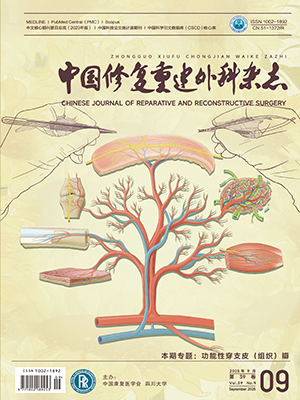To compare the effect of trehalose with that of different traditional cryoprotectants on human skin and to detect the new protection mechanism of trehalose in hypothermia. Methods The skins to be cryopreserved were first treated with DMSO/Propyleneglycol (D/P group), trehalose/DMSO (T/D group), DMSO/ serumfree keratinocyte medium
(D/K group), DMEM (DMEM group), respectively, so as to be compared with fresh skin (control grouop). Then the histological structure of skin of different groups was observed and analyzed by pathological technology (SP immunohistochemistry, DAB staining). Furthermore, the influence of trehalose on α-actinin at gene level with RT-PCR was investigated. The viabil ity of skin in 5 respective groups was evaluated by using succinate dehydrogenase (SDH). The experiments were carried out 14 days after cryopreservation. Results The results of immunohistochemistry showed that A values of control group, T/D group, D/P group, D/K group and DMEM group were 27.50 ± 7.92, 18.40 ± 5.81, 13.10 ± 5.11, 11.50 ± 4.54 and 5.30 ± 2.14, respectively. There was no significant difference between control group and T/D group (P gt; 0.05), but control group was significantly different from the other groups (P lt; 0.05). The results of PCR studies showed that A values of control group, T/D group, D/P group, D/K group and DMEM group were 0.816 ± 0.134, 0.723 ± 0.245, 0.564 ± 0.265, 0.245 ± 0.071 and 0.148 ± 0.048, respectively. Control group was not significantly different from T/D group and D/P group (P gt; 0.05), but was significantly different from D/K group and DMEM group (P lt; 0.05). The results of SDH showed that A valuse of control group, T/D group, D/P group, D/K group and DMEM group were 18.2 ± 3.7, 12.3 ± 3.6, 10.2 ± 2.4, 7.3 ± 2.1 and 5.7 ± 1.5, respectively. There was no significant difference between control group and T/D group (P gt; 0.05), while control group was significantly different from the other groups (P lt; 0.05). Conclusion The results suggest that cryopreservation protocol-trehalose/DMSO is better than the traditional cryoprotectant for ryopreservation on α-actinin of human skin.
Citation: JIA Xiaoming,YU Yu,LI Dongjie.. INVESTIGATION ON THE EFFECT OF TREHALOSE ON α-ACTININ IN CRYOPRESERVED HUMAN SKIN. Chinese Journal of Reparative and Reconstructive Surgery, 2008, 22(4): 446-449. doi: Copy
Copyright © the editorial department of Chinese Journal of Reparative and Reconstructive Surgery of West China Medical Publisher. All rights reserved




